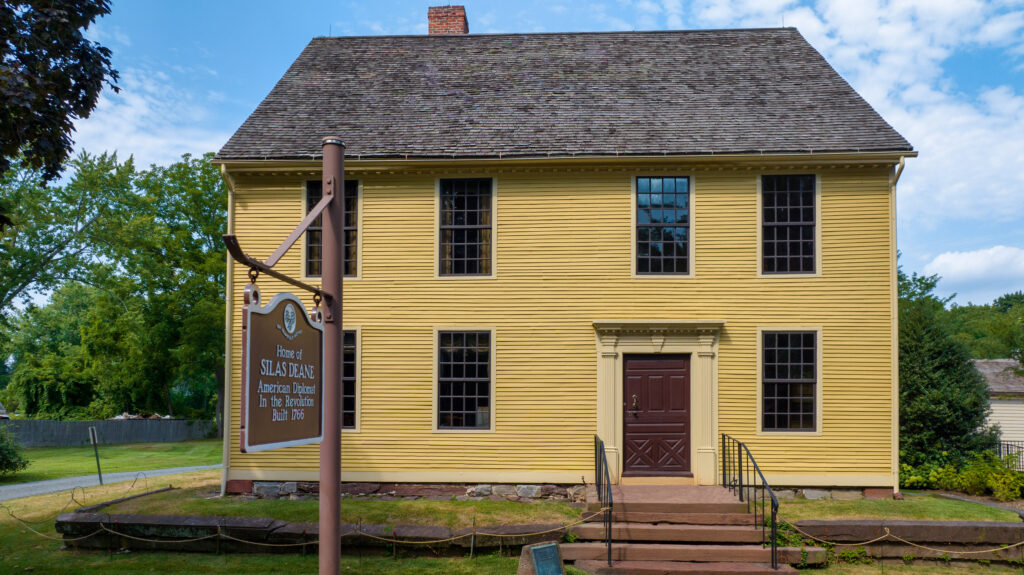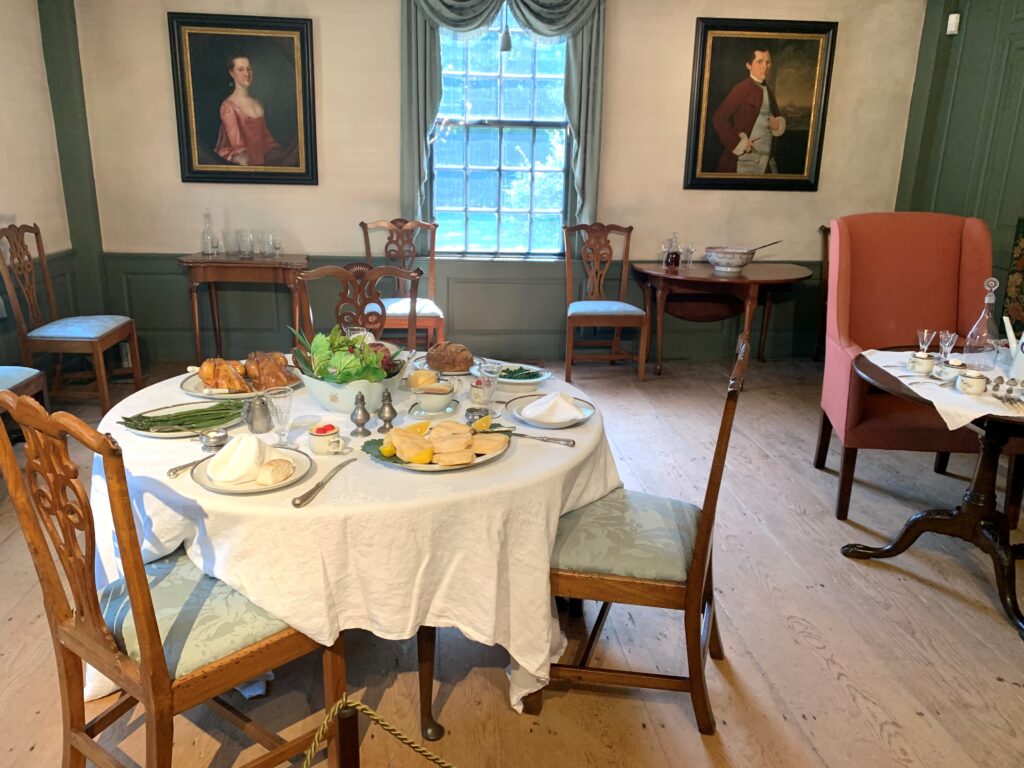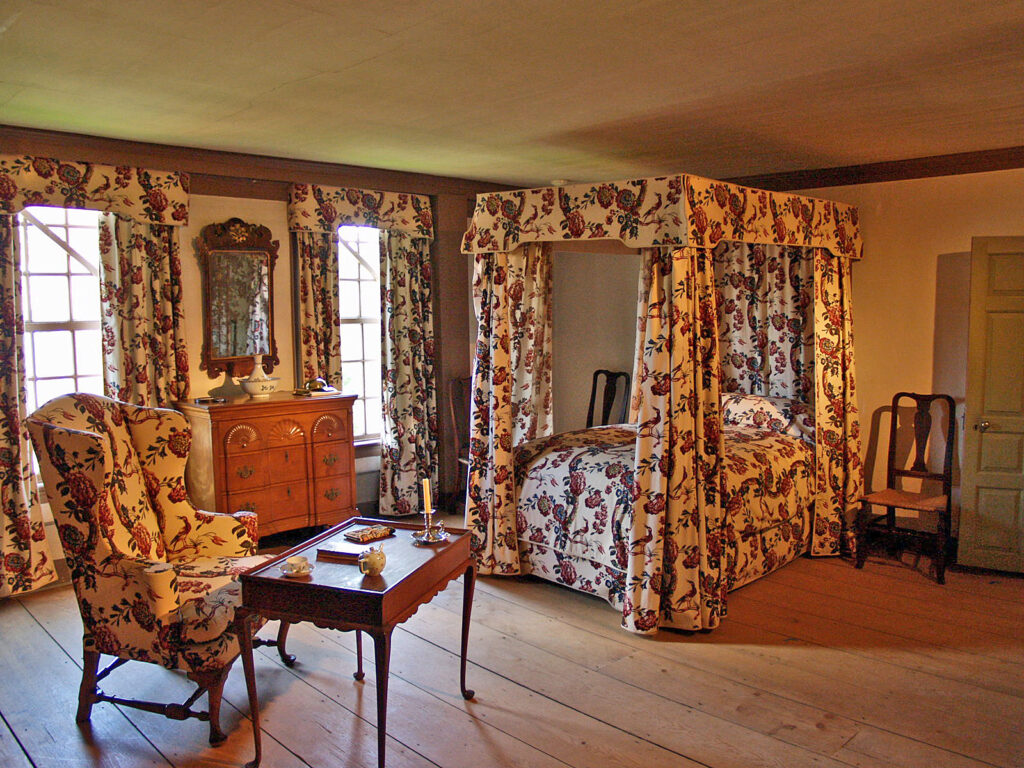Silas Deane House
The Deane House (a National Historic Landmark) was completed in 1769 and was the home of Silas and Elizabeth Deane. A rising star in local and regional politics, Deane designed his house to serve as a power base for his personal ambitions. Their new house, next door to the Joseph Webb House, features an asymmetrical façade which originally included a piazza or porch. The front door opens into a spacious hallway with a grand, well-lit staircase leading to what may have served as a musicians’ gallery. The ground floor was laid out to entertain and impress, featuring a best parlor with a carved Portland brownstone fireplace; a back parlor used for dining, and an oversized kitchen to prepare meals for large social gatherings.
Silas Deane graduated from Yale College in 1758 and was admitted to the bar in 1761. He established his law practice in Wethersfield, where he met and became the legal and business advisor to Joseph Webb’s widow, Mehitable. They married in 1763, and their son Jesse was born the following year. Mehitable died in 1767, leaving Deane to raise with young Jesse as well as the six Webb children. In 1769, Silas married another rich widow, Elizabeth Saltonstall Evards from New London. She was the granddaughter of a former governor of Connecticut. Her family’s stature and political connections undoubtedly helped Deane to advance his career.
An attorney and a representative to the Colonial Assembly in Hartford, Deane became involved in the events leading to the American Revolution. He was Secretary of Connecticut’s Committee of Correspondence, served as one of Connecticut’s delegates to the Continental Congress in 1774, and helped plan and finance the capture of Fort Ticonderoga in May of 1775. By June of 1776, he was in Paris secretly securing French military supplies for the patriot cause. Our nation’s first diplomat, he shared lodgings with Benjamin Franklin and signed the Treaties of Alliance and Commerce that Franklin negotiated with France, the first country to recognize the United States as an independent nation.
While Deane was away from home serving the Continental cause, his wife, Elizabeth, continued to entertain in their handsome new residence. In 1774, John Adams visited Wethersfield and took tea with Mrs. Deane. In 1775, George Washington dined with Elizabeth at the house while en route to take command of the troops outside of Boston. Elizabeth died in 1777 while Deane was still in Paris.
Deane’s distinguished reputation and accomplishments as a patriot and diplomat came under scrutiny beginning in 1777. Fellow commissioner, Arthur Lee, was jealous and suspicious of his colleagues. He accused Franklin of being too friendly with the French and Deane of misappropriating Government funds, when, in fact, both Beaumarche and Deane spent their own money in anticipation of being reimbursed by Congress. Hoping to be the sole commissioner to France, Lee persuaded his relatives in Congress to lead an effort to recall both Deane and Franklin to Philadelphia in 1778. The charges against Franklin were dropped, but those against Deane remained without his being given the opportunity to defend himself or to justify his claims for reimbursement. He returned to France in 1780 to document his claims and save his reputation.
Despondent and destitute, Deane later voiced his frustrations and anger in private letters to family and friends. Unbeknownst to Deane, his personal secretary, Edward Bancroft, was a British spy. Bancroft sent copies of these letters to the British home office, which had them published in a New York Tory newspaper. Written before, but published after the decisive American victory at Yorktown, Deane’s letters seemed defeatist, and he was branded by the press as a traitor. Back in London, the British government awarded Bancroft a pension of L1000 per year for his service as a spy.
Bancroft wrote to Jefferson that he often visited Deane, who moved to London in 1783, “to assist him with advice, medicines and money for his subsistence.” He also helped Deane get ready to return to America in 1789. But as the ship waited out a storm in the harbor, Deane suddenly became sick and died within four hours. Some historians suspect that Bancroft, who may have had reason to fear that Deane would reveal his secret, added poison to Deane’s medications. Deane was buried in an unmarked grave in Deal, England. His house and possessions were sold to satisfy his creditors. It was not until the 1830s that congress gave his descendants one third of the amount it owned him.
Stephen Chester purchased the Silas Deane House from Deane’s creditors sometime after 1790. From 1800 to 1873, it passed through many hands until it was bought by Frances Talcott Fenn in 1874. Her son, U.S. Representative E. Hart Fenn, inherited the house in 1899 and lived there with his second wife Margaret Clark Fenn. They made a few structural changes to the building, even going so far as to install the only bathtub in the basement. The house was damaged by fire in 1932, and the extent of the loss is unknown. Fenn inherited the Deane House upon the death of her husband in 1939. She was a Connecticut Colonial Dame; and at her death in 1958, she left the Deane house as a bequest to the NSCDA-CT.



